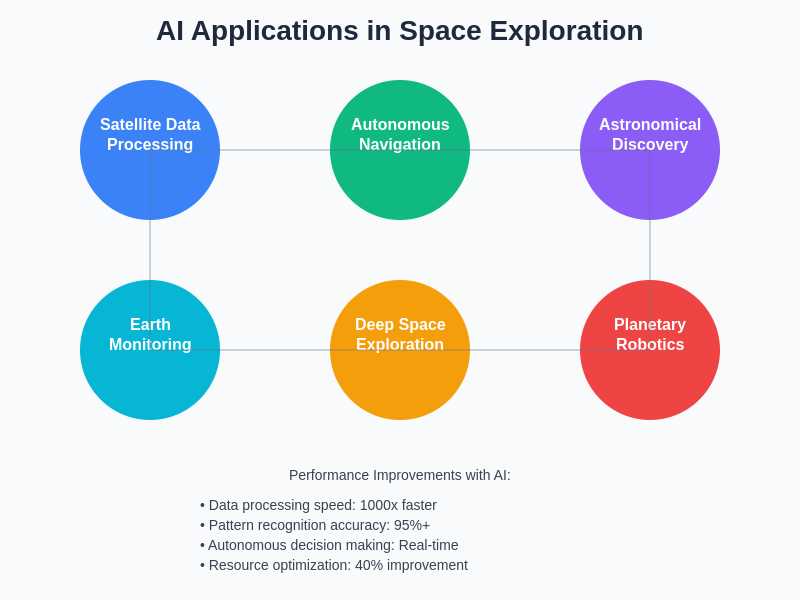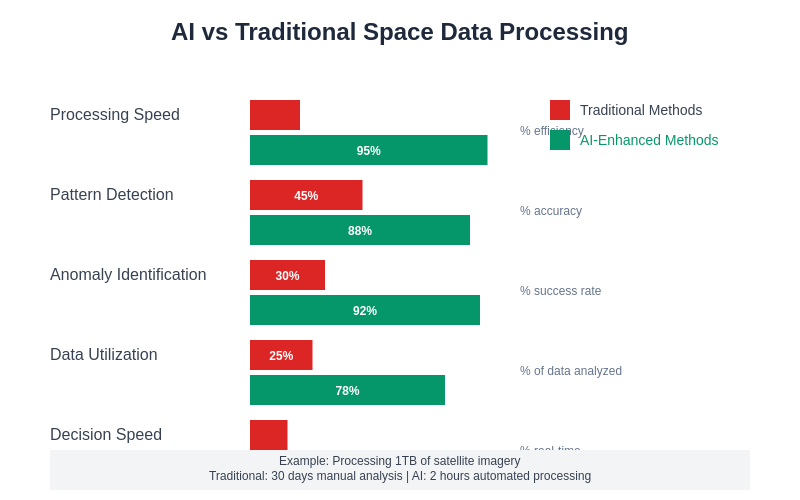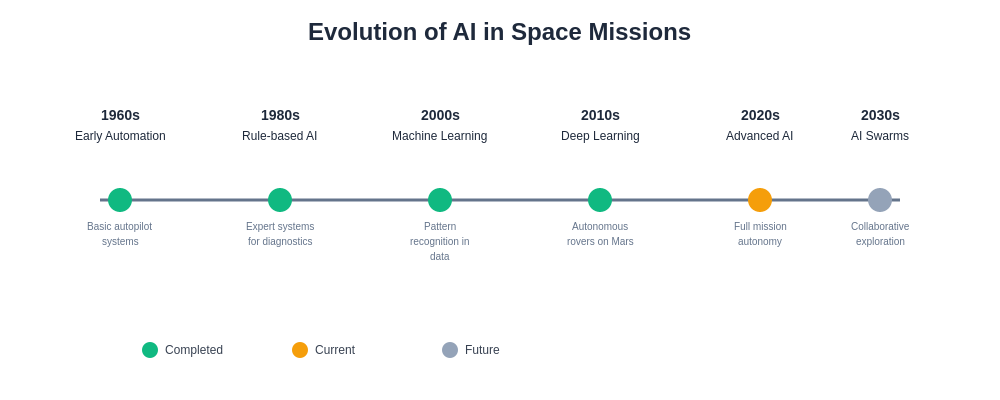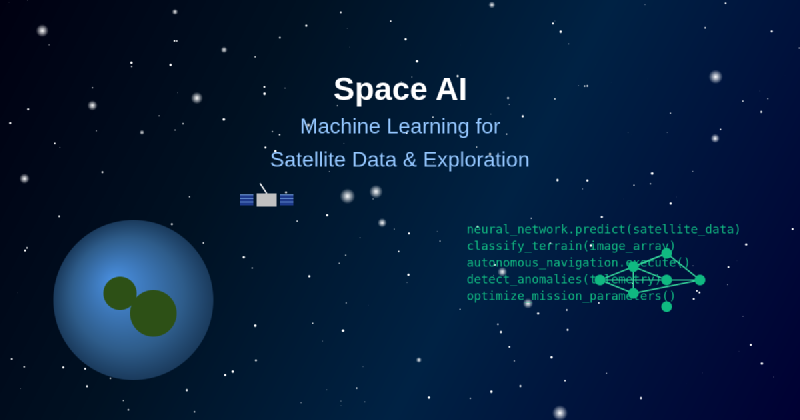The vast expanse of space has always captured human imagination, but today’s exploration efforts are powered by something far more sophisticated than mere curiosity and mechanical instruments. Artificial intelligence and machine learning have emerged as the driving forces behind modern space exploration, transforming how we collect, analyze, and interpret data from the cosmos. From autonomous spacecraft navigation to real-time analysis of satellite imagery, AI has become an indispensable tool that enables us to push the boundaries of human knowledge and exploration capabilities far beyond what was previously imaginable.
Explore the latest AI developments in space technology to stay informed about cutting-edge innovations that are reshaping our approach to cosmic exploration and satellite operations. The integration of artificial intelligence into space missions represents a fundamental shift in how we conduct scientific research beyond Earth’s atmosphere, opening new possibilities for discovery and understanding that were previously limited by human processing capabilities and the constraints of traditional computational methods.
The Evolution of Space-Based Artificial Intelligence
The journey of artificial intelligence in space exploration began with simple automated systems designed to perform basic functions without constant ground control intervention. However, the evolution has been remarkable, progressing from rudimentary rule-based systems to sophisticated machine learning algorithms capable of autonomous decision-making in the harsh and unpredictable environment of space. Modern AI systems deployed in space missions can process vast amounts of data in real-time, adapt to unexpected situations, and make critical decisions that would otherwise require time-consuming communication with Earth-based mission control centers.
This evolution has been driven by the unique challenges of space exploration, where communication delays, radiation exposure, and the need for autonomous operation have created an ideal testing ground for advanced AI technologies. The development of space-hardened AI systems has not only benefited space exploration but has also contributed to advancements in terrestrial AI applications, creating a symbiotic relationship between space technology development and general artificial intelligence research.
The current generation of space AI systems incorporates deep learning neural networks, computer vision algorithms, natural language processing capabilities, and advanced pattern recognition systems that can operate reliably in the extreme conditions of space. These systems are designed to handle everything from spacecraft navigation and instrument control to scientific data analysis and mission planning, representing a comprehensive integration of AI technologies into every aspect of modern space exploration.

The diverse applications of artificial intelligence in space exploration span multiple domains, from satellite data processing and autonomous navigation to astronomical discovery and planetary robotics. Each application area leverages specialized AI techniques optimized for the unique challenges of space environments, creating a comprehensive ecosystem of intelligent systems that work together to enhance mission capabilities and scientific outcomes.
Revolutionizing Satellite Data Processing and Analysis
Satellite data processing represents one of the most significant applications of machine learning in space technology, where the sheer volume of information collected by Earth observation satellites, deep space telescopes, and planetary exploration missions far exceeds the capacity for manual analysis. Machine learning algorithms have transformed this landscape by enabling automated classification, pattern detection, and anomaly identification in satellite imagery and sensor data, allowing scientists and researchers to extract meaningful insights from datasets that would otherwise remain unexplored due to their complexity and size.
The application of convolutional neural networks to satellite imagery has revolutionized fields such as climate monitoring, agricultural assessment, urban planning, and disaster response. These AI systems can automatically identify and track changes in land use patterns, detect deforestation activities, monitor crop health, assess damage from natural disasters, and identify potential security threats with accuracy levels that often exceed human capabilities. The speed and precision of AI-driven analysis have transformed satellite data from a valuable but underutilized resource into a real-time intelligence tool that informs critical decisions across multiple industries and government agencies.

The performance advantages of AI-enhanced data processing methods over traditional approaches are dramatic across all key metrics. While traditional methods rely heavily on manual analysis and rule-based systems, AI-powered solutions achieve significantly higher efficiency in processing speed, pattern detection accuracy, and real-time decision-making capabilities, fundamentally transforming how space agencies and researchers handle the enormous volumes of data generated by modern space missions.
Experience advanced AI capabilities with Claude for complex data analysis and research tasks that require sophisticated reasoning and pattern recognition similar to those used in satellite data processing. The techniques developed for space-based AI applications have found widespread application in terrestrial data science and machine learning projects, demonstrating the cross-pollination of innovation between space exploration and commercial AI development.
Autonomous Navigation and Mission Control Systems
The implementation of AI-driven autonomous navigation systems has fundamentally changed how spacecraft operate in the vast emptiness of space, where traditional navigation methods based on ground-based tracking and manual course corrections are often inadequate for complex missions. Modern spacecraft equipped with machine learning algorithms can navigate independently using onboard sensors, stellar references, and predictive models that account for gravitational influences, solar radiation pressure, and other environmental factors that affect spacecraft trajectory and orientation.
These autonomous systems have proven particularly valuable for missions to distant planets and asteroids, where communication delays with Earth can range from minutes to hours, making real-time human control impossible. AI navigation systems can process sensor data from cameras, radar, lidar, and other instruments to create detailed maps of terrain, identify safe landing sites, avoid obstacles, and execute complex maneuvers without waiting for instructions from ground control. This capability has enabled missions such as autonomous asteroid sampling, precision planetary landings, and close-proximity operations around celestial bodies that would be impossible with traditional navigation methods.
The development of these systems has required significant advances in edge computing, as spacecraft must process complex algorithms using limited computational resources while operating in the harsh radiation environment of space. The resulting technologies have applications beyond space exploration, contributing to advances in autonomous vehicles, robotics, and other terrestrial applications that require reliable autonomous navigation in challenging environments.
Machine Learning Applications in Astronomical Discovery
The field of astronomy has been transformed by machine learning applications that can process and analyze the enormous datasets generated by modern telescopes and observational instruments. Traditional astronomical research was limited by the time-intensive nature of manual data analysis, where astronomers could examine only a small fraction of available observations. Machine learning algorithms have removed this bottleneck by automating the detection and classification of astronomical objects, enabling the analysis of millions of stars, galaxies, and other celestial phenomena with unprecedented speed and accuracy.
Deep learning networks have proven particularly effective at identifying rare astronomical events such as gravitational wave signals, exoplanet transits, supernovae, and gamma-ray bursts in vast datasets where these phenomena represent tiny signals hidden within enormous amounts of background noise. The ability of AI systems to detect subtle patterns and correlations that might escape human observation has led to numerous astronomical discoveries, including the identification of new classes of astronomical objects and the detection of previously unknown phenomena that expand our understanding of the universe.
The success of machine learning in astronomical discovery has also contributed to the development of more sophisticated data collection strategies, where AI systems can guide telescope pointing decisions, optimize observation schedules, and prioritize data collection efforts based on the likelihood of making significant discoveries. This feedback loop between AI analysis and data collection has created a more efficient and productive approach to astronomical research that maximizes the scientific value of limited observational resources.
Earth Observation and Environmental Monitoring
Satellite-based Earth observation powered by artificial intelligence has become an essential tool for monitoring environmental changes, tracking climate patterns, and managing natural resources on a global scale. Machine learning algorithms applied to satellite imagery can detect and quantify changes in forest cover, ice sheet thickness, urban development, agricultural productivity, and water quality with temporal and spatial resolution that was previously unachievable through traditional monitoring methods.
The application of AI to environmental monitoring has proven particularly valuable for tracking rapid environmental changes such as wildfire spread, flood extent, oil spill dispersion, and volcanic activity, where timely information is critical for emergency response and disaster management. Machine learning systems can automatically detect these events in near real-time, generate alerts for relevant authorities, and provide detailed assessments of affected areas that inform response strategies and resource allocation decisions.
Access comprehensive research capabilities with Perplexity for in-depth analysis of environmental data and satellite observations that require sophisticated information synthesis and pattern recognition. The integration of AI into environmental monitoring represents a significant advancement in our ability to understand and respond to environmental challenges, providing the data and insights necessary for evidence-based environmental policy and management decisions.
Deep Space Exploration and Autonomous Operations
Deep space missions represent the ultimate test of autonomous AI systems, where spacecraft must operate independently for years or decades while traveling vast distances from Earth. The development of AI systems capable of maintaining spacecraft health, conducting scientific observations, and adapting to unexpected situations without human intervention has enabled ambitious missions to the outer planets, asteroid belt, and beyond that would be impossible with traditional mission architectures.
Machine learning algorithms deployed on deep space missions can optimize power consumption, manage instrument operations, detect and respond to system failures, and prioritize data transmission based on scientific value and communication opportunities. These systems must operate reliably for extended periods while exposed to cosmic radiation, extreme temperatures, and other environmental hazards that can degrade electronic systems over time.
The success of AI-driven deep space missions has provided valuable insights into the design and implementation of long-duration autonomous systems that have applications in other challenging environments, including underwater exploration, polar research, and remote industrial operations. The techniques developed for deep space AI have contributed to advances in fault-tolerant computing, adaptive algorithms, and resilient system architectures that benefit numerous terrestrial applications.
Planetary Surface Exploration and Robotics
The exploration of planetary surfaces has been revolutionized by AI-powered robotic systems that can navigate complex terrain, conduct scientific investigations, and make autonomous decisions about research priorities and operational strategies. Mars rovers equipped with machine learning capabilities can identify interesting geological formations, select samples for analysis, and adapt their exploration strategies based on discoveries and environmental conditions without waiting for instructions from Earth.
Computer vision algorithms enable these robotic explorers to navigate safely across unknown terrain, avoiding hazards such as loose rocks, steep slopes, and soft soil that could damage or immobilize the vehicles. Machine learning systems can also analyze scientific data in real-time, identifying significant discoveries that warrant detailed investigation and ensuring that limited operational resources are focused on the most scientifically valuable activities.
The development of AI-powered planetary exploration systems has advanced the field of mobile robotics, contributing to improvements in autonomous navigation, environmental perception, and decision-making algorithms that benefit terrestrial applications such as search and rescue operations, environmental monitoring, and industrial automation.
Spacecraft Health Monitoring and Predictive Maintenance
The application of machine learning to spacecraft health monitoring has transformed how space agencies maintain and operate complex space systems, where traditional maintenance approaches based on scheduled inspections and component replacement are impractical due to the inaccessibility of spacecraft once they are deployed. AI-driven health monitoring systems can continuously analyze telemetry data from spacecraft subsystems to detect early signs of component degradation, predict potential failures, and recommend operational adjustments that extend mission lifespans.
These predictive maintenance systems utilize pattern recognition algorithms to identify subtle changes in system performance that might indicate developing problems, enabling proactive responses that prevent catastrophic failures. Machine learning models trained on historical mission data can predict the remaining useful life of spacecraft components, optimize resource allocation decisions, and identify operational strategies that maximize mission success probability while minimizing risk.
The techniques developed for spacecraft health monitoring have found applications in terrestrial industries where remote monitoring and predictive maintenance are valuable, including power generation, transportation, and manufacturing sectors. The demanding requirements of space applications have driven innovations in sensor technology, data analysis methods, and predictive modeling that benefit numerous industrial applications.
Communication and Data Management Systems
The management of communication and data transmission between spacecraft and ground stations has been significantly enhanced by AI systems that can optimize bandwidth utilization, prioritize data transmission, and adapt communication strategies based on link quality and operational requirements. Machine learning algorithms can predict communication window availability, optimize data compression techniques, and manage the complex scheduling requirements of deep space networks that support multiple simultaneous missions.
AI-driven communication systems can also enhance data quality through intelligent error correction, adaptive modulation techniques, and interference mitigation strategies that improve the reliability and efficiency of space-to-Earth communications. These systems are particularly valuable for missions that generate large volumes of scientific data that must be transmitted through limited communication channels with varying quality and availability.
The advances in AI-driven communication systems developed for space applications have contributed to improvements in terrestrial communication networks, satellite internet systems, and mobile communication technologies that face similar challenges related to bandwidth optimization, interference management, and adaptive transmission strategies.
Space Weather Prediction and Mitigation
Space weather represents a significant challenge for space-based systems and astronaut safety, where solar storms, cosmic radiation, and other space environment phenomena can damage electronic systems, degrade communication links, and pose health risks to crew members. Machine learning systems trained on historical space weather data and solar observations can predict space weather events with improved accuracy and longer lead times, enabling proactive measures to protect spacecraft and astronauts.
AI-powered space weather prediction systems can analyze data from solar observation satellites, ground-based telescopes, and space environment monitoring instruments to identify patterns that precede significant space weather events. These predictions enable mission planners to adjust spacecraft operations, postpone critical activities, and implement protective measures that minimize the impact of space weather on mission success and safety.
The development of space weather prediction systems has contributed to advances in predictive modeling, pattern recognition, and real-time data analysis that benefit terrestrial weather forecasting, climate modeling, and other applications that require analysis of complex environmental systems with multiple interacting variables.
Resource Identification and Utilization
The identification and utilization of space-based resources represents a critical capability for future long-duration space missions and permanent space settlements, where traditional approaches of carrying all necessary supplies from Earth become economically and logistically impractical. Machine learning systems can analyze spectral data from planetary surfaces, asteroid compositions, and lunar samples to identify locations of water, minerals, and other resources that could support human activities in space.
AI-driven resource identification systems can process data from multiple sensors and instruments to create detailed maps of resource distribution, assess extraction feasibility, and optimize resource utilization strategies that maximize efficiency and minimize environmental impact. These capabilities are essential for missions that involve in-situ resource utilization, where spacecraft and habitats must be supplied using materials available in the local space environment.
The techniques developed for space-based resource identification have applications in terrestrial mining, geological exploration, and environmental assessment, where similar challenges exist in analyzing complex datasets to identify valuable resources while minimizing exploration costs and environmental impact.
Future Directions and Emerging Technologies
The future of AI in space exploration promises even more sophisticated capabilities as advances in quantum computing, neuromorphic processors, and advanced algorithms become available for space applications. Quantum computing systems adapted for space use could enable unprecedented computational capabilities for complex optimization problems, cryptography, and data analysis tasks that exceed the capabilities of current classical computing systems.
Neuromorphic computing architectures that mimic biological neural networks could provide extremely efficient AI processing capabilities that are well-suited to the power and computational constraints of space missions. These systems could enable more sophisticated AI capabilities while consuming less power and exhibiting greater resistance to radiation damage than traditional electronic systems.
The integration of AI with emerging space technologies such as solar power satellites, space-based manufacturing, and interplanetary transportation systems will create new opportunities for autonomous operation and optimization that could significantly reduce the cost and complexity of space activities while enabling capabilities that are impossible with current approaches.
Advanced AI systems may also enable new forms of space exploration, such as self-replicating robotic explorers that could spread throughout the solar system, conducting comprehensive surveys and establishing infrastructure for human activities. These systems would represent the ultimate expression of autonomous space exploration, capable of independent operation across vast scales of time and distance.
The continued development of AI for space applications will require ongoing collaboration between space agencies, academic researchers, and commercial companies to address the unique challenges of space environments while leveraging advances in terrestrial AI research. This collaboration will continue to drive innovations that benefit both space exploration and terrestrial applications, maintaining the symbiotic relationship between space technology development and broader scientific advancement.
The convergence of AI, space exploration, and emerging technologies promises to unlock new possibilities for understanding the universe, expanding human presence beyond Earth, and addressing global challenges through space-based solutions. The next decade will likely see the deployment of AI systems that surpass current capabilities by orders of magnitude, enabling space exploration and utilization activities that today exist only in the realm of science fiction.

The historical progression of artificial intelligence in space missions demonstrates a clear trajectory from basic automation to sophisticated autonomous systems. This evolution continues to accelerate, with current advanced AI capabilities paving the way for future collaborative exploration systems that will enable unprecedented levels of autonomous operation and scientific discovery across the solar system and beyond.
Disclaimer
This article is for informational purposes only and does not constitute professional or technical advice. The views expressed are based on current understanding of AI technologies and their applications in space exploration. Readers should consult with qualified professionals and conduct their own research when considering the implementation or investment in space-based AI technologies. The rapidly evolving nature of both AI and space technology means that specific capabilities and applications may change significantly as these fields continue to advance.
